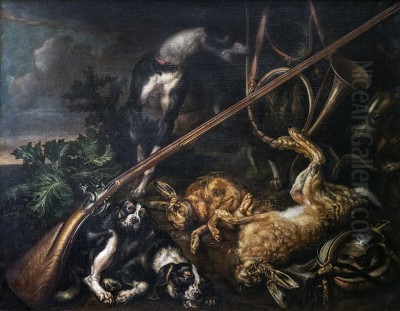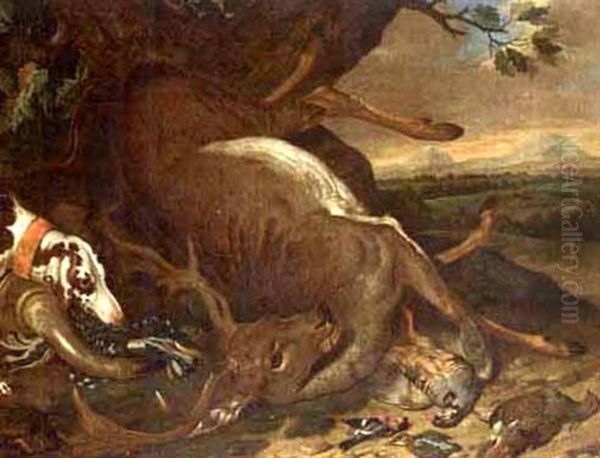
Philipp Ferdinand de Hamilton stands as a notable figure in the landscape of 18th-century European art, particularly within the circles of Central European courts. Born into an artistic dynasty and active primarily in Vienna, his career was marked by a dedication to the genres of animal painting and still life, with a particular emphasis on capturing the essence of the hunt and the natural world. His long tenure as a court painter underscores his skill and the appeal of his work to the aristocratic patrons of the era.
Early Life and Artistic Formation
Philipp Ferdinand de Hamilton entered the world in Brussels in 1664. His artistic path was significantly shaped by his family background. He was one of three sons of James Hamilton, a painter of Scottish origin who had established himself on the continent. It was James who provided Philipp Ferdinand with his foundational training in painting, immersing him in the techniques and traditions of the craft from an early age. This familial instruction set the stage for his future career.
He was not the only son to follow in his father's footsteps. His brothers, Johann Georg de Hamilton and Karl Wilhelm de Hamilton (the latter sometimes known as "Thistle-Hamilton"), also became accomplished painters. Together, the Hamilton brothers formed a remarkable artistic lineage, carving out niches for themselves primarily as court painters across various principalities in Central Europe, continuing a tradition of specialized animal and still-life painting.
The Viennese Court Painter
The most significant chapter of Philipp Ferdinand de Hamilton's professional life began in 1705 when he was appointed as a court painter (Hofmaler) to the imperial court in Vienna. This prestigious position was one he would hold for an impressive forty-five years, serving until his death in 1750. Vienna, as the heart of the Habsburg Empire, was a major cultural and artistic center, and securing a role at court was a testament to his abilities and reputation.

As a court painter, his responsibilities likely involved creating works that catered to the tastes and interests of the imperial family and the aristocracy. Given his specialization, this would have included detailed depictions of hunting expeditions, prized animals from the imperial menageries or stables, game pieces representing successful hunts, and decorative still lifes suitable for palace interiors. His long service suggests his work was consistently valued by his patrons.
Artistic Style and Specialization
De Hamilton's oeuvre is characterized by its focus on the animal kingdom and the bounty of nature, often intertwined with the theme of the hunt, a favoured pastime of the European nobility. He excelled in capturing the textures of fur and feathers, the anatomy of various animals, and the dramatic interplay often found in hunting scenes or depictions of game. His still lifes ranged from elaborate arrangements of dead game (game pieces) to simpler compositions featuring fruit or even fungi.
His style likely combined the detailed realism inherited from Flemish and Dutch traditions of still life and animal painting with the somewhat more opulent or dramatic flair often associated with Baroque court art. Precision, careful observation, and a high degree of finish are hallmarks often attributed to painters in his genre and position. He aimed to create images that were both accurate representations and aesthetically pleasing compositions.
Notable Works
Several works highlight Philipp Ferdinand de Hamilton's skill and thematic interests. His Still Life with a Bear in a Winter Landscape from 1737 is a compelling example of his ability to integrate animals into atmospheric settings. An earlier piece, sometimes titled Pantry with Pheasant and Dead Cat (1707), showcases his talent for detailed still life featuring game. Studies, such as his Study of Deer, reveal his commitment to accurately rendering animal forms.
His repertoire also included numerous still lifes focused purely on game or natural elements. Works like Still Life with a Hare (1730), Still Life with Fieldfares (1730), and Still Life with Dead Birds (1720) exemplify the popular genre of the game piece. He also explored other still life subjects, as seen in Still Life with Mushrooms (1700) and Still Life with Bottles (1701). A late work, Still Life with Fruit (1750), indicates his continued activity until the end of his life. Another notable piece is the intricately detailed Still Life with Partridge, Brambling, Common Kingfisher, Snow Bunting and Goldfinch. These works collectively demonstrate his consistent focus and technical proficiency.
The Hamilton Dynasty: Family and Artistic Context
Philipp Ferdinand was part of a unique artistic phenomenon – a family where the father and all three sons achieved recognition as painters, largely within the same specialized genres. His father, James Hamilton, provided the initial training and perhaps stylistic direction. His brother, Johann Georg de Hamilton, was also a highly regarded painter of animals, particularly horses, and served various courts, including time in Berlin. Karl Wilhelm de Hamilton, the third brother, similarly specialized in still lifes and animal subjects.
This familial concentration on animal and still-life painting, particularly in service to Central European courts, is remarkable. While Philipp Ferdinand established himself firmly in Vienna, his brothers found patronage elsewhere. The shared specialization undoubtedly fostered a degree of similarity in their work, likely stemming from their common training under their father. It's also plausible that a sense of professional, albeit perhaps amicable, rivalry existed between the brothers as they navigated the competitive world of court patronage, each developing nuances within their shared field.
Wider Artistic Milieu
While the provided records emphasize Philipp Ferdinand de Hamilton's familial connections, placing him within the broader art historical context reveals more potential influences and parallels. His work belongs to a strong tradition of animal and still-life painting that flourished in the Low Countries and spread throughout Europe. He follows in the footsteps of earlier Flemish masters like Frans Snyders and Jan Fyt, renowned for their dynamic hunting scenes and elaborate still lifes, whose influence permeated the genre.
In the Dutch tradition, painters like Jan Weenix specialized in dead game pieces, often set in park landscapes, bearing resemblance to the types of subjects Hamilton tackled. Melchior d'Hondecoeter's detailed depictions of birds, both domestic and exotic, also form part of the rich background against which Hamilton worked. Although specializing in different, often larger-scale religious or historical subjects, prominent Austrian Baroque painters active in Vienna during Hamilton's tenure, such as Johann Michael Rottmayr, Martino Altomonte, and Paul Troger, formed the vibrant artistic environment of the court he served.
Closer to his specific genre, Franz Werner von Tamm was another artist known for still life painting who was active in Vienna around the same period. Looking towards the German tradition, earlier masters like Georg Flegel had laid groundwork in meticulous still life, while Abraham Mignon (though German-born, active mainly in the Netherlands) excelled in fruit and flower pieces. While direct collaboration or documented exchange between Philipp Ferdinand and many of these artists isn't specified in the source materials, their work collectively represents the artistic landscape and established traditions within which he operated and found his own successful niche. His father James Hamilton and brothers Johann Georg de Hamilton and Karl Wilhelm de Hamilton remain his most direct artistic relations.
Later Life and Legacy
Philipp Ferdinand de Hamilton remained active as Vienna's court painter until his death in the city in 1750. He reached the advanced age of 86, capping a long and productive career dedicated to his craft and his patrons at the imperial court. His legacy lies in his contribution to the specific genres of animal painting and still life within the context of 18th-century Central European art.
His works were held in high regard, finding places in significant collections, including those mentioned in Vienna and Munich. As a member of the Hamilton artistic family, he played a key role in establishing and continuing a tradition of specialized painting that catered effectively to the tastes of the aristocracy. He remains a representative figure of the skilled court artist, adept at capturing the natural world with precision and aesthetic appeal.
Conclusion
Philipp Ferdinand de Hamilton emerges from the historical record as a dedicated and skilled specialist painter. Born in Brussels and trained by his father, he spent the majority of his long career in service to the Habsburg court in Vienna. His focus on animals, hunting scenes, and detailed still lifes placed him firmly within a popular tradition, yet he carved out his own identity, contributing significantly to the artistic production of the Viennese court for nearly half a century. Alongside his brothers, he represents a fascinating instance of a family dynasty specializing in a particular artistic niche, leaving behind a body of work appreciated for its technical skill and its reflection of aristocratic life and interests in the 18th century.